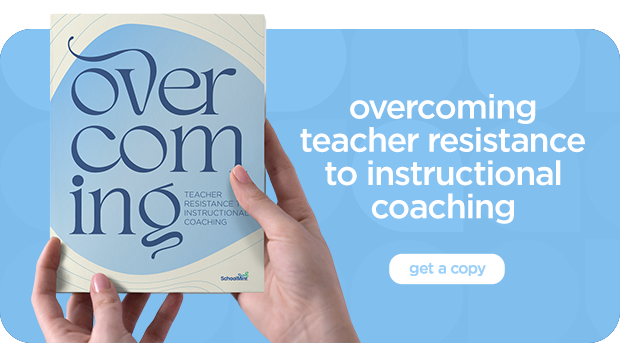10 Reasons Teachers Resist Instructional Coaching and What You Can Do
The implementation of instructional coaching in our K-12 schools as a professional development tool to improve teachers’ instructional practices has become nearly ubiquitous over the past two decades.
The empirical evidence provides support for the positive impacts of instructional coaching. For example:
- Implementing instructional coaching can lead to improvements in classroom instruction as well as drive improvements in students’ skills and achievement (Biancarosa et al. 2010, Elish-Piper and L’Allier 2011, Matsumura et al. 2013).
- In a review of numerous studies, Kretlow and Bartholomew found that coaching improved teachers’ practice in all studies they reviewed.
Although there is great complexity and differences in the various coaching models, there is also great variability in the willingness of teachers to work with a coach to change their instruction.
Regardless of the instructional coaching approach or model, not all teachers are receptive to coaching. This is due to numerous factors. But the fact is some teachers prefer not to engage in the coaching process, which demands communication, collaboration, and change.
Short on time? Want to share this with a colleague? You can download this blog as a beautiful .pdf here or by clicking the image below.
Teacher Resistance in Instructional Coaching
Change is a particularly difficult process for teachers, and instructional coaching requires teachers to address changes in three broad ways:
- They must change their schedules to accommodate regular communication and meetings with a coach.
- They must understand and accept the notion that every teacher can improve their pedagogical skills.
- They must make good faith efforts to adapt and change their instructional practices based on the coach’s feedback and expectations for teacher growth.
As noted above, coaching is a highly collaborative process in which coaches and teachers have a shared goal. Together, they define their work and how it fits into the larger school schema.
Many studies have indicated that teachers can be highly resistant to entering into such a relationship, with their resistance manifesting as either overt or covert behaviors.
Why Can Teachers Resist Coaching?
Musanti and Pence believe that coaching resistance is the result of “a long tradition of isolation within the classroom walls deeply instilled in school culture. When this tradition is disrupted, teachers feel exposed, vulnerable, and powerless.”
Even though skilled coaches may help a majority of teachers warm up to coaching, there is likely to be a core of teachers who remain unwilling to engage in coaching in a meaningful way. For them, additional options may be required.
It’s Human Nature to Resist Change
When teachers exhibit overt or covert resistance, they may be viewed as a “tough crowd” and may generally be resistant to many professional development activities, such as instructional coaching.
But the fact is human beings hardwired to resist change. For example:
- In the brain, the amygdala views changes in the environment as threatening, which causes a release of specific hormones to invoke a fight or flight response.
- With this biological resistance, there are other reasons why teachers may be resistant to instructional coaching.
Rosabeth Moss Kanter with Harvard Business Review posits there are 10 reasons people resist change in the corporate world.
These reasons can be directly applied to the educational environment and the instructional coaching scenario. By understanding these reasons (as outlined below), educational leaders can proactively mitigate teachers’ resistance to instructional coaching.
1. Loss of Control
Loss of control relates to autonomy and agency, as resistant teachers also express an exaggerated need to maintain “professional autonomy and independence.” Thus, resistance to change for some can be understood as an expression of teachers’ professional and intellectual freedom and personal agency.
Additionally, some teachers have deeply held beliefs or professional commitments that are at odds with the proposed instructional coaching changes — what is referred to as principled resistance. Potential change coming from an outside source may threaten a teacher’s sense of self-determination.
Solution
- School leaders can help overcome this sense of loss of control by leaving room for teachers to make some choices.
- Invite them into the planning of the instructional coaching program, thus giving them ownership and agency.
- A platform like SchoolMint Grow can make the process highly collaborative, transparent, and efficient for teachers and coaches both.
2. Excess Uncertainty
Change can sometimes feel like jumping off a diving board with a blindfold. As the saying goes, “Better the devil you know than the devil you don’t know.”
We fear the unknown.
Some people can cognitively create scenarios that exacerbate the natural fear engendered by uncertainty. This fear may make resistant teachers say and do things they would not normally say and do. It shows up as opposition, confrontation, or unwillingness to engage in coaching.
Solution
- Overcoming this inertia requires a sense of safety as well as an inspiring vision.
- Create certainty of the process with clear, simple steps and timetables.
- Sharing research and other sources of information about instructional coaching will help to reduce uncertainty.
- A coaching platform like SchoolMint Grow facilitates transparency in coaching and makes it easy for coaches and teachers to build a positive coaching relationship.
3. Surprise
Often you will hear people in organizations respond to information about coming changes by saying, “Why didn’t we know about this earlier?”
The decision to implement a coaching program and then suddenly communicate this to teachers — who were given no time to prepare or process the change for the consequences — will, unsurprisingly, engender resistance.
One of our SchoolMint Grow clients, Explore Schools, used a slow rollout to successfully implement their coaching program across their charter network.
Solution
- Avoid a process of creating a program change in secret and then announcing the changes all at once.
- The more effective process is to “plant seeds” about instructional coaching. Provide bits of information over time of what might be coming in the future.
You can learn more about establishing a culture of coaching in our previous article, It Starts with a Sticky Note: Building a Coaching Culture in Your School.
4. Everything is Different
Teachers are highly variable in their attitudes toward growth and change.
Resistant teachers, according to Zimmerman, are especially reluctant to change when they “do not believe a change is needed, are reluctant to change their routines, view past change as unsuccessful, perceive change as a threat to relationships with colleagues and school leadership (e.g., principals), or feel their expertise would be undermined by change.”
When we implement an instructional coaching program, some things are inevitably going to change, and change is meant to bring on something different — but how different?
We are creatures of habit. Routines become automatic, but change that is too dramatic creates great unease. Too many differences can be confusing, and people will wonder how all the changes will impact their lives.
Solution
- Try to minimize the number of unrelated differences introduced by the central change of a coaching program.
- Wherever possible, keep things familiar.
- Remain focused on the most important aspects of the coaching program.
Check out this previous article, 4 Steps to Implementing Teacher Coaching in Your School, for tips on successfully implementing a new coaching program.
5. Loss of Face
Depending on the school, teachers who teach in the “old way of doing things” may be defensive about changes. The implication to these staff members is “The way we have been teaching is not working.”
When change involves a big shift of strategic direction toward coaching, teachers who supported the previous direction may fear they must have been wrong all along.
Solution
- Help people maintain dignity by celebrating those aspects of the instructional models of the past that are worth keeping.
- Make it clear that evidence supports instructional coaching as a way to improve student outcomes.
6. Concern About Competence
In most cases, coaches do not evaluate teachers. However, there is still an underlying belief that the coach has greater expertise in important areas of subject matter and pedagogical practices.
Thus, a dynamic is inherent in the relationship such that power and identity come into play and can affect how receptive a teacher is to being coached.
Although different coaching models are being practiced in schools today (i.e., directive, dialogical, facilitative) relative to the structure of the teacher and coach roles, “by definition, the teacher–coach relationship invokes coaches as holding expertise relative to the practitioners with whom they work.”
Teachers involved in instructional coaching are exposing their professional skills in a very open manner during the instructional coaching process.
Coaches typically observe teachers instructing students, managing classrooms, and creating lesson plans. Teachers may resist change here because they feel they may be exposed as not being competent.
They might express skepticism about whether coaching is really an improvement, but deep down, they are worried any skill deficits they have will be exposed.
Solution
- Over-invest in structural and cultural reassurance that coaching is a private matter between the coach and teacher.
- Assure teachers that coaching is a “gift” that helps even the most effective teacher continue to grow.
- Regardless of coaching prowess, even the most seasoned coaches may struggle in their interactions with teachers who are highly reluctant to work with them due to the competence factor.
- It’s important to support coaches as well when they have difficult teachers to work with.
Watch the video below to learn how coaching happens at Athur Ashe Charter School in New Orleans, Louisiana:
7. More Work
This cause for resistance is very much universal, and the unavoidable fact is that the change of implementing an instructional coaching program and fulfilling the requirements of quality coaching is indeed more work for everyone involved.
Those responsible for designing the program and implementing it are often overloaded. This certainly adds new things to teachers’ workflow, and leaders must be sensitive and cognizant that they simply may not have the personal “battery power” to implement coaching effectively at this time.
One common phenomenon observed in districts is initiative fatigue.
With initiative fatigue, educators face new, transformative initiatives on a regular basis. They may feel as if they simply do not have the energy to engage in “one more thing.”
Solution
- Acknowledge the hard work involved in doing instructional coaching by ensuring teachers have time to engage in meaningful ways.
- Create clear project plans, meeting times, and timelines so people will feel the plan is reasonable to incorporate into their schedules.
- Consider adding extra incentives for participants.
- In the final analysis, move only as fast as time and your staff’s energy will allow.
- When using a platform like SchoolMint Grow, demonstrate the ways in which software can actually reduce the feelings of coaching being “one more thing.”
8. Ripple Effects
When implementing any initiative in education, it’s critical to understand the linkages with other ongoing initiatives. Teachers often ask how this initiative dovetails with other initiatives, and the resistant teacher may view instructional coaching as interfering with other important work.
This is when teachers start to push back, rebelling against changes they had nothing to do with that interfere with their own preferred activities.
Similar to throwing a pebble into a pond, change creates ripples that move across the institutional pond in ever-widening circles. These ripples can disrupt much other work in unintended ways.
Solution
- Map out how all existing programs and initiatives interact and support each other in a coherent manner.
- Clearly articulate this to staff.
- If using a software for coaching, show how this platform facilitates existing processes and makes them easier.
9. Past Resentments
Veteran teachers may have been part of past program implementations that were not entirely successful. These historical failures, at least in the minds of the resistant teachers, open the possibility that a new instructional coaching initiative will follow the same course.
Some veteran teachers also take the stance when a new program is implemented that this too shall pass as each new administration tries to make their mark on the institution with the next great transformative change.
Additionally, some teachers may hold personal cynicism toward administrators based on past interactions. This can create quite negative emotions and engender resistance. Old wounds reopen, and they remember historic resentments — sometimes going back many years.
Solution
- Analyze past unsuccessful program implementations.
- Report to teachers how prior shortcomings will be rectified during the new implementation.
- Continue to present the empirical evidence of the efficacy of instructional coaching.
10. Coaching Model Mismatch
Each teacher enters the teacher–coach relationship with a unique conception of the coaching role and relationship with their coach, and they may hold entirely different expectations for their coaching relationship than the coach does.
For example:
- Some teachers are well-aligned with the shared problem-solving approach of coaching.
- Some expect coaches to provide expert advice and resources.
- Others like coaches who simply validate their current practice.
Coaching models generally approach resistant teachers as those with whom coaches need to expend more effort and time on to eventually establish a trusting, productive relationship.
3 Approaches to Teacher Coaching
In terms of matching coaching models with teachers, one schema outlining the approaches to coaching has been developed by Dr. Jim Knight.
1. Teacher Coaching: Facilitative Approach
The facilitative approach encourages coaches to share their ideas openly by listening with empathy, paraphrasing, and asking powerful questions. This approach is a somewhat passive role.
The coach does not share their expertise or suggestions with respect to what a teacher can do to get better. Instead, they keep their ideas and knowledge to themselves.
- Facilitative works best when the teachers being coached already have the knowledge.
- Facilitative is less effective when teachers do not have the knowledge they need to address issues in the classroom.
2. Teacher Coaching: Directive Approach
At the other extreme is the directive approach. The coach is viewed to have special knowledge to transfer to the teacher, and the coach helps the teacher master the special skills.
The coach gives advice, and the relationship is similar to a master/apprentice relationship.
3. Teacher Coaching: Dialogical Approach
Between the facilitative and direct approach rests the dialogical approach, which has aspects of both the facilitative and directive.
The coach asks powerful questions, listens, and collaborates to set goals. The coach does not withhold their expertise but falls short of giving advice. The dialogical coach helps teachers look at what research has identified as effective teaching strategies.
Solution
- To address potential mismatches in expectations, the coach must focus on their own interpersonal and relationship-building skills with the teacher at the outset.
- Coaches must establish rapport and trust with teachers who may be initially hesitant.
- At least initially, it is key to adjust their coaching role to the teacher’s needs and preferences. As the relationship develops, the expectation is that teachers will be more receptive to acquiring the knowledge, motivation, skills, and self-efficacy needed to improve their pedagogy (Cantrell and Hughes 2008, Mangin 2009).
- Coaches should consider adjusting their coaching approach depending on the situation. By listening carefully to what teachers say and the questions they ask, the coach can determine the best stance (facilitative, directive, dialogical) to take to support the teacher, changing direction and stance as needed.
A study by Jacobs, Wang & Boardman (2017) examined a group of teachers who were resistant and found two broad manifestations:
- “Lack of buy-in,” which is often seen as not finding time for coaching.
- “Resistant to coaching,” which is seen as not implementing the feedback of their coaches.
Jacobs, et. al. suggests this indicates that program buy-in and resistance to coaching are independent phenomena and should be addressed separately by coaches and school leaders.
This also indicates that the 10 reasons that teachers might be resistant can also be categorized as lack of buy-in or resistance to coaching, each of which require different approaches to ameliorate.
Interested in learning how a teacher coaching platform like SchoolMint Grow can accelerate teacher growth in your school/district?
- Using SchoolMint Grow for Teacher Coaching in Your School
- Using SchoolMint Grow for Teacher Coaching in School Districts
- Using SchoolMint Grow for Leadership Coaching Organizations
To see SchoolMint Grow in action for yourself, let‘s talk. Click to get in touch with one of SchoolMint‘s instructional coaching experts.
Share this
You May Also Like
These Related Stories

Special Considerations of Instructional Coaching for Middle School Teachers

A Conversation on Coaching: Interview with Dr. Jim Knight



